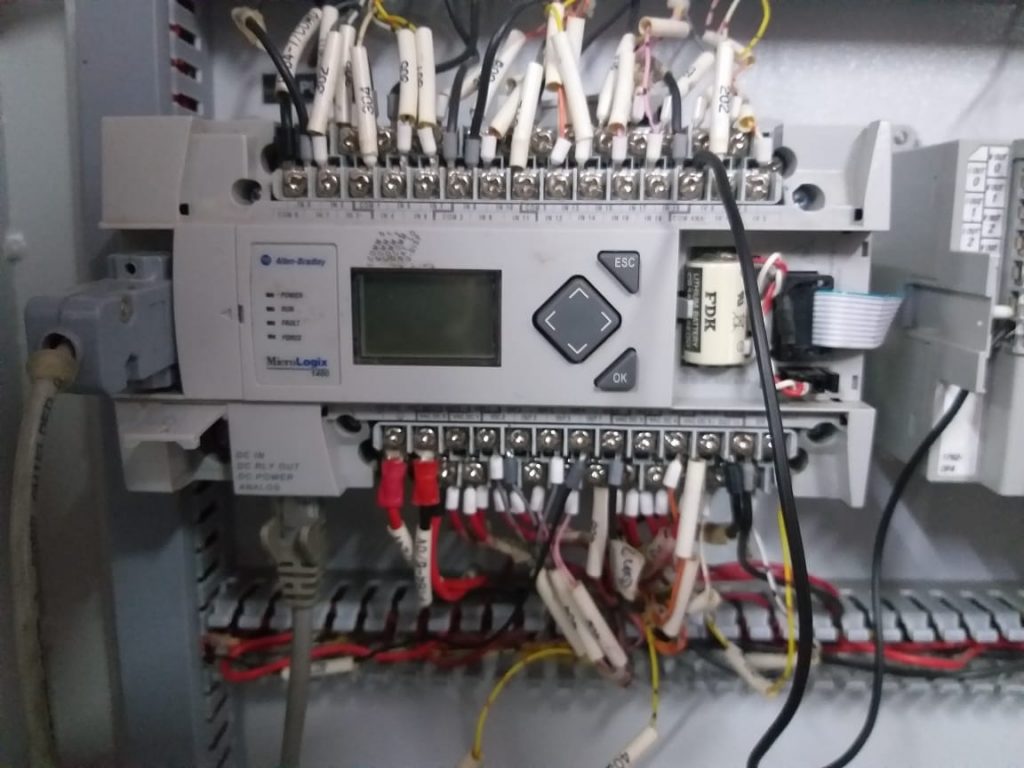What's the History of the PLC?

A programmable logic controller (PLC) is a piece of equipment that is designed to control a computer system in an industrial setting. A PLC is always monitoring a specified set of inputs and then making decisions to alter what output devices are doing. In this article, we'll take a look at the history of the PLC.
PLCs are commonly used to monitor motors or machines, and today, are the foundation of a predictive maintenance system. Predictive maintenance allows a manufacturing company to identify potential breakdowns and problems before they cause major issues or result in significant downtime.
PLC Timeline
In 1969, Dick Morley was running a small business out of a garage and serendipitously built the first PLC. He humbly states, “We were building it and didn’t know we were building it.” Morley kept the relay design simple with four outputs, and the automotive manufacturers snapped up the technology.
In the early days, Morley said the automotive companies wanted to purchase the PLC at an ever-declining price. Although Morley was skeptical about the viability of the business long-term, a colleague convinced him to take the deal as the real money to be made in PLC was in the repair and maintenance of systems once they were implemented.
Four years later, in 1973, Michael Greenburg designed the first commercially successful PLC, which was further developed by Modicon to replace relay-based technology for both General Motors and Landis.
PLCs use ladder logic and essentially brought to life physical relays, timers, and wired connections. By eliminating the requirement for rewiring and new hardware for every additional logical configuration, PLCs drastically boosted the functionality of controls without adding to the physical space required for additional hardware and equipment. However, the original PLCs had little memory capability, could not handle off-site inputs and outputs, and needed proprietary terminals for new programming.
By the 1980s, PLC technology had made great strides. At this point, PC-based software could handle programming requirements, processing speed was greatly increased, and new features were now available. PLCs have continued to add new developments almost continuously since then.
In 2001, the market research firm ARC came up with the term programmable automation controller (PAC) to describe a highly advanced PLC that incorporates PC-based software, human-machine interface (HMI), and sophisticated asset management. As this technology took off, particularly in larger organizations, some experts predicted the death of the old-fashioned PLC systems.
However, according to Frost & Sullivan, the global PLC market has grown in recent years. As smaller and medium-sized organizations look to expand their markets, PLCs will continue to play a critical role in helping them fuel that growth.
What Does a PLC Do?
The tasks of a PLC have changed significantly since its advent in 1969. Essentially, a PLC is a control system that is used in manufacturing and other industrial applications. Its job is to continuously monitor particular inputs, run those inputs through a computer system, and then generate the correct outputs for a particular process.
Production lines, industrial machines, or manufacturing processes are frequently improved and more efficient with the help of a PLC. These systems are designed to help alter or duplicate a particular operation or manufacturing process while gathering and sharing critical information to help businesses make smarter decisions.
All PLC systems are modular, which means you can customize the types of input devices such as sensors as well as how the data is shared on the output side to best suit your business.
What Is the Difference Between PLC and Related Technologies?
When you have a technology like PLC that has been around for more than half a century, it’s understandable that related technologies and advancements are created over the years. For professionals in the industry, understanding the nuisances, differences, and similarities are critical to be able to select and use the tools best suited for a particular application.
In some cases, complementary technologies are developed and the line between the tools begins to blur, making the differentiation between technologies a little more complex.
PLC and PAC
Traditionally, PLCs have been used for machine control. In the beginning, this was simple control for equipment. But over time, PLC technology has evolved to handle high-speed control as well. PLCs perform program execution scans using limited memory and focuses on a discrete set of inputs and outputs.
PACs, which were developed much later, perform well in complex automation system architectures. These architectures may include many PC-based software applications such as HMI features, asset management, or advanced process control. If a company has extensive process control requirements, PAC can better manage analog inputs and outputs, offer greater programming flexibility, provide larger memory capacity, and present better interoperability.
PLC and SCADA
When professionals discuss PLC in the context of a supervisory control and data acquisition (SCADA) system, they often say simply that PLC is the hardware and SCADA is the software.
Within industrial settings, PLC and SCADA are often used together to create an automated system for predictive maintenance. Input data is collected from individual equipment through sensors or other reporting technologies and sent to the PLC, which then converts the information into a usable format for the SCADA software.
Technicians or managers then use HMI to tap into the data. If particular ranges are exceeded or other thresholds are passed, a work order may be generated or an alert is sent to a maintenance manager for immediate action.
PLC and DCS
Although a PLC can scale easily, each PLC is typically responsible for one piece of equipment or set of processes. A distributed control system (DCS) is essentially several PLCs that work together to manage an entire plant or manufacturing facility.
A DCS controls many processes variables at the same time, and a maintenance manager can have a better view of the entire status of the plant while each controller manages its own PLC system. The entire DCS is connected through sophisticated communication and monitoring technologies.
PLC and DDC
Direct digital control (DDC) is another tool that is often used in conjunction with PLC and may be added to a PLC itself. DDC can also be distributed over a network or sit on a desktop computer. The technology helps read sensor data, processes it into the correct domain, and controls actuators. DDC is common within the building automation arena.
PLC and HMI
As we’ve already noted, HMI is the acronym for human-machine interface and works with PLC. It is typically a local machine and the user interface that allows a technician to interact directly with the piece of equipment. HMIs allow a person to look at specific data, control the input and output, and enter related decisions into the computerized system.
Conclusion
PLC technology has a long history within industrial companies, providing a breakthrough tool that has helped businesses become more efficient in managing their equipment, processes and systems over the years. As the technology has advanced, complementary tools have evolved, allowing industrial companies to expand their use and applications of PLC throughout an entire facility.
As smaller and medium-sized companies continue to compete in the global marketplace, they will increase their use of PLC and related technologies to grow and thrive into the future.
Want to keep reading?
Predictive Maintenance: What is it? [Types, Comparison, & Benefits]
What is the difference between PLC and SCADA?
SCADA: What It Is and How It Works
4,000+ COMPANIES RELY ON ASSET OPERATIONS MANAGEMENT
Leading the Way to a Better Future for Maintenance and Reliability
Your asset and equipment data doesn't belong in a silo. UpKeep makes it simple to see where everything stands, all in one place. That means less guesswork and more time to focus on what matters.

![[Review Badge] Gartner Peer Insights (Dark)](https://www.datocms-assets.com/38028/1673900494-gartner-logo-dark.png?auto=compress&fm=webp&w=336)
